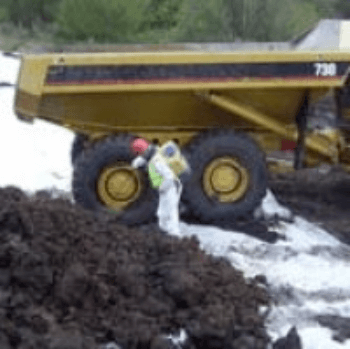
INNSA Standard
BURIAL OF JAPANESE KNOTWEED
Soil containing Japanese knotweed material may be buried on the site where it is produced. You must comply with local laws. In England, you must inform the Environment Agency at least one week prior to the burial; please refer to the EAs Regulatory Position Statement 178 for further guidance.
Prior to burial of the Japanese knotweed, you should apply a non-persistent herbicide such as glyphosate if the plant is in leaf; this should reduce the growth of the viable material. You should check the product label, which will inform you of the ‘active’ period of the herbicide; material may not be buried during this period.
The materials to be buried should consist of soil and stones containing Japanese knotweed only; do not bury rubble or other contaminants (including household waste).
You have two options when burying Japanese knotweed:
- Cover the material with at least 5m (depth) of clean soils (preferably separated by a geotextile root barrier membrane on the surface of the contaminated material)
- encapsulated the material completely within a geotextile membrane and cover the capsule with at least 2m (depth) of clean soils
It is therefore likely that you will be making and working in deep excavations, and you must accordingly take appropriate safety precautions.
You should choose a suitable location for the burial pit which is not likely to be disturbed, not earmarked for future development, landscaping or the installation or roads, public open space or services.
The location of the burial cell should be accurately recorded on the relevant documentation (deeds, site plans and the KMP) to ensure that it is properly managed in the long term. You should advise the local Environment Agency office of the location of the burial cell.
Consideration and / or consultation with the Contaminated Land Consultant should also take place is there is any risk of pollutant leakages occurring or pre-existing contamination being affected by the formation of a burial chamber.
Many root barrier membranes are available which claim to prevent Japanese knotweed penetrating. A root barrier membrane is only as good as the way in which it has been laid, expert supervision is essential when the root barrier membrane is installed.
Where the encapsulation method is used, your excavation should be lined along the bottom and the sides before any contaminated material are imported. it is vital that the integrity of the membrane is maintained at all times. it is important to have a minimum amount of seams; if any Japanese knotweed does have the strength to regenerate, it may break through any holes or poorly-welded joints.
Given that the rhizomes may remain dormant for 20 years, it is important that the supplier of the membrane gives a guarantee exceeding this, with a minimum specification of 50 years or greater.
